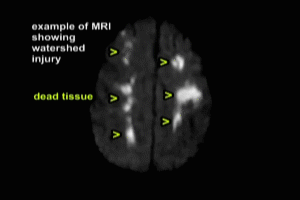Watershed Stroke Transcript
Watershed Stroke
This is Dr. Cal Shipley with a review of watershed stroke.
Global Loss of Blood Flow
Among the causes of ischemic stroke in the human brain is global loss of blood flow. Global blood flow loss may occur in any condition in the body in which there is a generalized loss of blood flow to all organs.
Causes of Global Blood Flow Loss
Conditions which can lead to global blood flow loss include severe loss of blood volume, as in hemorrhagic shock; rhythm disturbances of the heart, such as ventricular fibrillation or cardiac arrest; infectious states with blood-borne infection (also known as septicemia), and narcotics overdose.
Watershed Stroke
The typical brain injury that occurs with a global loss of blood flow is known as a watershed stroke.
The Watershed Area
To better understand how this occurs, let’s take a look at the blood flow patterns in the brain. Here’s a view of the brain in cross-section looking from above. The arterial blood flow to the brain is such that there is a flow from the outer edge towards the center of each cerebral hemisphere, as well as a flow from the inner edge towards the center of each cerebral hemisphere. Where the inner and outer flows meet is known as the watershed area.
It therefore follows that when there is a generalized loss of blood flow to the brain, such as in narcotic overdosage, the watershed areas of each hemisphere are particularly susceptible to ischemia and stroke. Seen from above in both our animation and in an MRI, watershed stroke has a very characteristic appearance.
Cal Shipley, M.D. copyright 2020

